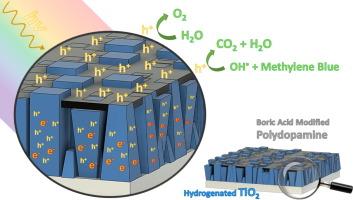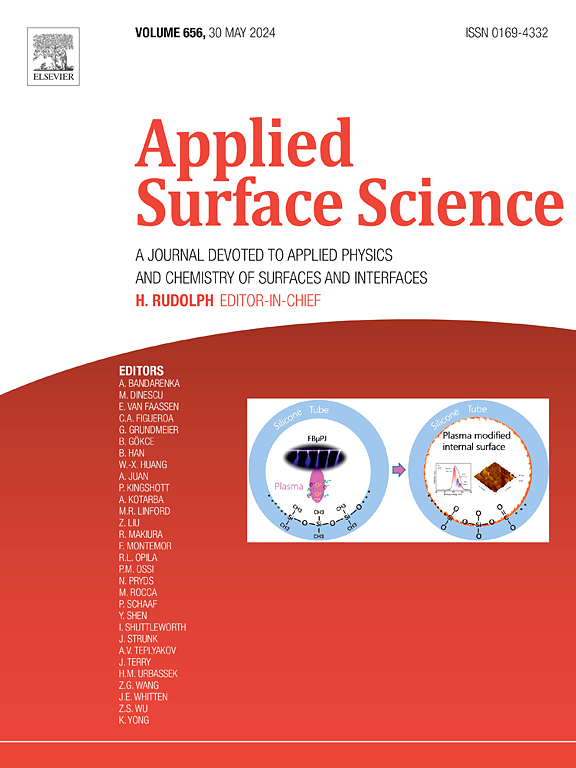Boric acid modified polydopamine and nanocolumnar hydrogenated TiO2 nanocomposite with improved photocatalytic performance
IF 6.9
2区 材料科学
Q2 CHEMISTRY, PHYSICAL
引用次数: 0
Abstract
Hydrogenation has been established as one of the most common approaches to increase the photocatalytic efficiency of TiO2 nanomaterials. Nanocolumnar hydrogenated TiO2 (H:TiO2), obtained through a combination of DC reactive magnetron sputtering and hydrogenation treatments, could serve as an efficient photocatalyst, provided that its chemical stability and the lifetime of its photogenerated charge carriers are improved. One possible strategy to achieve this is the large-scale deposition of the nanometrically thin free-standing polydopamine film from the air/water interface. This exciting approach is feasible due to the superior mechanical stability of the boric acid-modified polydopamine (BAPDA) thin films. The gradual preparation protocol successfully produced the BAPDA/H:TiO2 nanocomposites, as revealed by X-ray diffractometry, Raman spectroscopy, atomic force microscopy and X-ray photoelectron spectroscopy. Next, comparing bare H:TiO2 and BAPDA/H:TiO2, 0.15 eV bandgap redshift was observed through UV–vis spectroscopy. Additionally, photoelectrochemical tests provided auspicious results for photocatalytic oxidation by an increase in photocurrent density in the anodic regime and more negative polarization of the BAPDA/H:TiO2 photoelectrode. Analysis of the open circuit photopotential decay curve indicated a rise in photogenerated electron lifetime. Finally, photocatalytic Methylene Blue degradation tests demonstrated a higher photocatalytic efficiency for the nanocomposite resulting from the boric acid-modified polydopamine deposition.


硼酸修饰聚多巴胺与纳米柱状氢化TiO2纳米复合材料的光催化性能
加氢是提高TiO2纳米材料光催化效率的最常用方法之一。采用直流反应磁控溅射和加氢相结合的方法制备的纳米柱状氢化TiO2 (H:TiO2),在提高其化学稳定性和光生载流子寿命的前提下,可以作为一种高效的光催化剂。实现这一目标的一个可能策略是在空气/水界面上大规模沉积纳米级薄的独立聚多巴胺薄膜。由于硼酸修饰的聚多巴胺(BAPDA)薄膜具有优异的机械稳定性,这种令人兴奋的方法是可行的。通过x射线衍射、拉曼光谱、原子力显微镜和x射线光电子能谱分析发现,采用渐进式制备方案成功制备了BAPDA/H:TiO2纳米复合材料。接下来,对比裸H:TiO2和BAPDA/H:TiO2,通过紫外可见光谱观察到0.15 eV带隙红移。此外,光电化学测试通过增加阳极状态下的光电流密度和BAPDA/H:TiO2光电极的负极化,为光催化氧化提供了有利的结果。开路光势衰减曲线分析表明,光生电子寿命增加。最后,光催化亚甲基蓝降解测试表明,由硼酸修饰的聚多巴胺沉积而成的纳米复合材料具有更高的光催化效率。
本文章由计算机程序翻译,如有差异,请以英文原文为准。
求助全文
约1分钟内获得全文
求助全文
来源期刊

Applied Surface Science
工程技术-材料科学:膜
CiteScore
12.50
自引率
7.50%
发文量
3393
审稿时长
67 days
期刊介绍:
Applied Surface Science covers topics contributing to a better understanding of surfaces, interfaces, nanostructures and their applications. The journal is concerned with scientific research on the atomic and molecular level of material properties determined with specific surface analytical techniques and/or computational methods, as well as the processing of such structures.
 求助内容:
求助内容: 应助结果提醒方式:
应助结果提醒方式:


